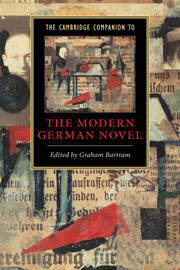Book contents
- Frontmatter
- 1 The German novel in the long twentieth century
- 2 Contexts of the novel
- 3 The novel in Wilhelmine Germany
- 4 Gender anxiety and the shaping of the self in some modernist writers
- 5 Franz Kafka
- 6 Modernism and the Bildungsroman
- 7 Apocalypse and utopia in the Austrian novel of the 1930s
- 8 Images of the city
- 9 Women writers in the ‘Golden’ Twenties
- 10 The First World War and its aftermath in the German novel
- 11 The German novel during the Third Reich
- 12 History, memory, fiction after the Second World War
- 13 Aesthetics and resistance
- 14 The kleiner Mann and modern times
- 15 The ‘critical’ novel in the GDR
- 16 Identity and authenticity in Swiss and Austrian novels of the postwar era
- 17 Subjectivity and women’s writing of the 1970s and early 1980s
- 18 The postmodern German novel
- Index
- Series List
9 - Women writers in the ‘Golden’ Twenties
Published online by Cambridge University Press: 28 May 2006
- Frontmatter
- 1 The German novel in the long twentieth century
- 2 Contexts of the novel
- 3 The novel in Wilhelmine Germany
- 4 Gender anxiety and the shaping of the self in some modernist writers
- 5 Franz Kafka
- 6 Modernism and the Bildungsroman
- 7 Apocalypse and utopia in the Austrian novel of the 1930s
- 8 Images of the city
- 9 Women writers in the ‘Golden’ Twenties
- 10 The First World War and its aftermath in the German novel
- 11 The German novel during the Third Reich
- 12 History, memory, fiction after the Second World War
- 13 Aesthetics and resistance
- 14 The kleiner Mann and modern times
- 15 The ‘critical’ novel in the GDR
- 16 Identity and authenticity in Swiss and Austrian novels of the postwar era
- 17 Subjectivity and women’s writing of the 1970s and early 1980s
- 18 The postmodern German novel
- Index
- Series List
Summary
Throughout the western world, the bob-haired, short-skirted, athletic young woman was an icon of the 1920s. The new constitution of the Weimar Republic brought women the vote and most formal educational bars were removed. The feminisation of clerical employment, the fastest growing sector of the economy, continued apace. Young women earning a wage packet were in less of a hurry to marry and men, it seemed, no longer expected to marry a virgin. As Lynn Abrams points out in chapter 2, however, the perception of a gender revolution was not entirely borne out in practice: the figures for female employment scarcely changed between the turn of the century and the mid-1920s although the distribution across different sectors did; only 8 per cent of girls took higher school grades compared with 25 per cent of boys; and the new sexual culture was accompanied by a massive abortion rate, estimated at one million in 1931. In practice sexual liberation often meant sexual exploitation, intensified demographically by the surplus of women following the war and by gender hierarchy in employment. German abortion law, the most liberal in Europe following reform in 1926, still prescribed criminal sanctions and remained the focus of large-scale protest. The first generation of women graduates entered the work-force just as a first devaluation of the academic professions was setting in, worsened by the great inflation and the crisis of 1929. Psychologically, an acute generation gap between young working women and their mothers fuelled the tensions between emancipation and femininity.
- Type
- Chapter
- Information
- The Cambridge Companion to the Modern German Novel , pp. 123 - 137Publisher: Cambridge University PressPrint publication year: 2004



